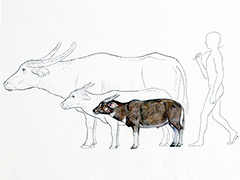But Size Doesn’t Matter: How we’re Shrinking in the Heat
Nov 11

Gingerich and his team, however, have discovered evidence of a separate and less extreme hyperthermal event occurring 2 million years after the PETM. They’ve dubbed this period ETM2 (Eocene Thermal Maximum 2), and increased global temperature approximately 5 degrees Fahrenheit whereas the PETM peaked at a 14-degree increase. What’s important about ETM2 is that it suggests a pattern—not only of global warming but of subsequent mammalian “dwarfing.”
"The fact that it happened twice significantly increases our confidence that we're seeing cause and effect,” said Gingerich, “that one interesting response to global warming in the past was a substantial decrease in body size in mammalian species.”
The team of universities concluded that smaller body size "seems to be a common evolutionary response" by mammals to extreme global warming events, "and thus may be a predictable natural response for some lineages to future global warming."
Sources:
http://www.enn.com/wildlife/article/46629
http://www.ucmp.berkeley.edu/tertiary/eocene.php




